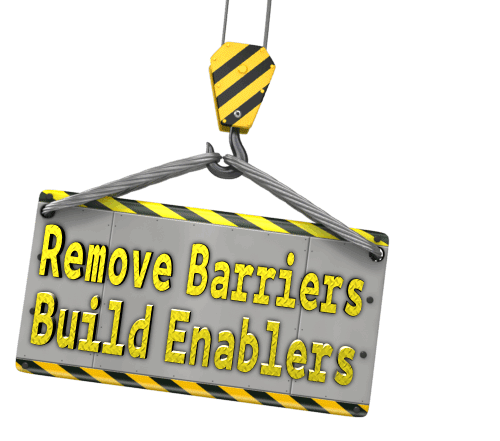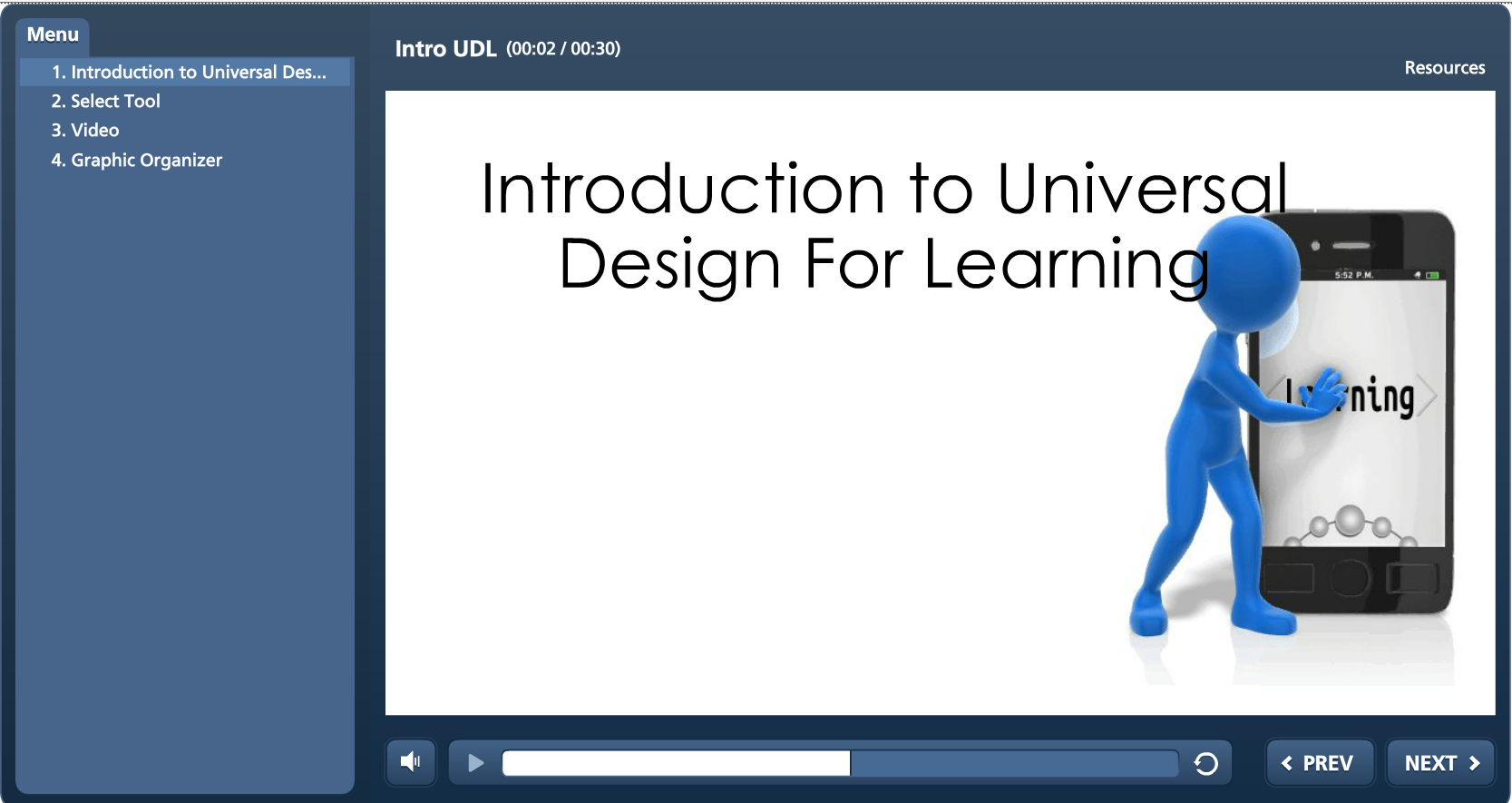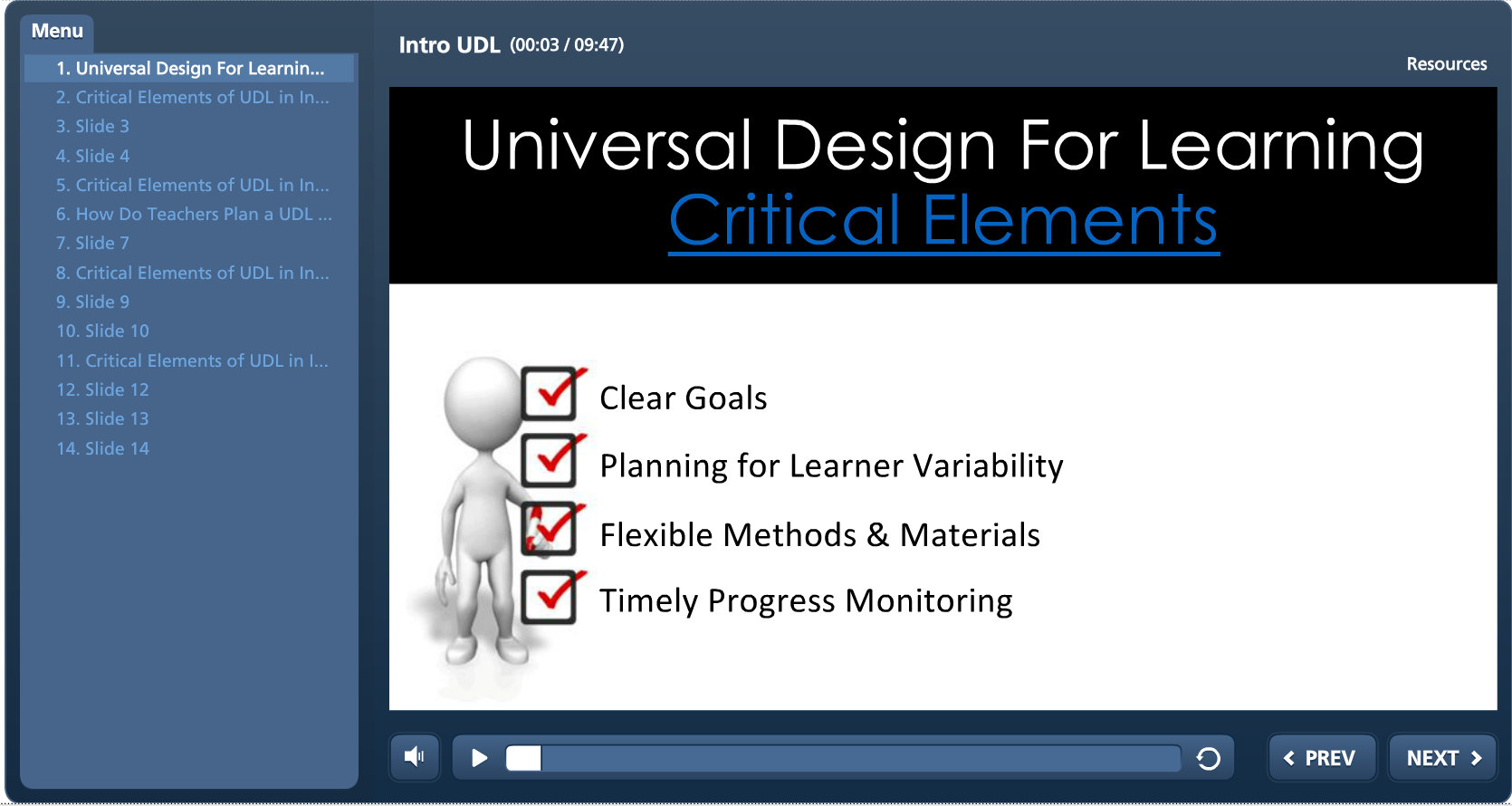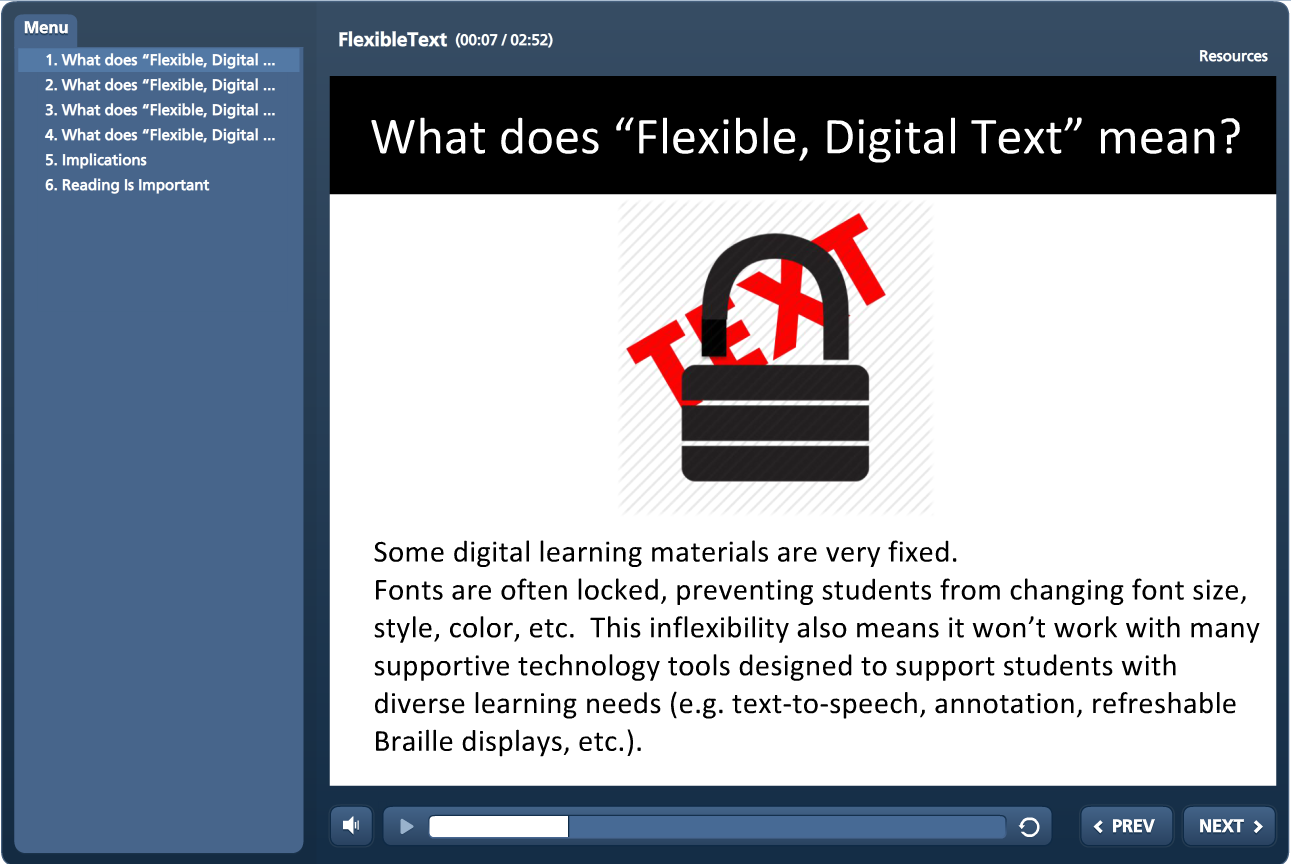4.3 Universal Design For Learning
| Sitio: | Alma |
| Curso: | TRIG Course- Alma College Winter 2015 |
| Libro: | 4.3 Universal Design For Learning |
| Imprimido por: | Invitado |
| Día: | domingo, 14 de diciembre de 2025, 09:56 |
1. Introduction: Universal Design For Learning
To listen to this introduction, click the audio link below
Developing a deep understanding of learner diversity is the first step toward meeting the needs of all the students in your classroom. With diversity in mind, educators can begin to create lessons that reduce the barriers to learning and include support structures that make learning possible for all students, we call this Universal Design for Learning.
The central idea behind Universal Design for Learning (UDL) is that instruction is designed to be “smart from the start.” In our design of instruction, we create lessons, activities, tests, and materials that can be used by diverse students, or those with many different abilities, preferences, and characteristics. As we deliver instruction, we provide different ways for individuals to receive information and interact with information. As we assess what students know and have learned, we consider options that enable all learners to fully show what they know.

To take an example from the world around us, consider curb cuts. Curb cuts were installed to enable people who use wheelchairs to move more freely throughout the environment. Curb cuts remove the barrier to sidewalk access and egress. But the truth is we all take advantage of this design when biking or pushing a stroller or wheeling our luggage behind. This is an example of universal design. Our task is to create curb cuts for education. That is, universally designed instruction that removes the barriers and benefits everyone—not just students with disabilities.
.
Special education often involves making adjustments to meet the needs of individuals with disabilities. In the classroom, these adjustments may entail differentiated instruction, individualized instruction, accommodations, modifications—or other commonly-used practices. It is important to realize that UDL is a different idea—we are not taking standardized instructional practices and retrofitting them to meet the needs of individuals with disabilities. Rather, we design instruction—from the start—that is appropriate for the needs and characteristics of all of the students in our classrooms—including those with disabilities.

Goals:
- Prepare educators to create a supportive and inclusive learning environment where all students successfully participate and learn.
- Understand the need to proactively design instructional opportunities to eliminate barriers and include curriculum enablers that support students in the margins.
Objectives:
- List the 3 principles of Universal Design for Learning.
- Describe UDL's critical elements and their impact on designing instruction.
- Apply the principles of Universal Design for Learning to a lesson.
2. Think: Universal Design for Learning
- View the video entitled "Which Students Benefit from UDL" to hear Michigan teachers talk about the impact that teaching with the UDL framework has on students in their classrooms.
-
Guiding Questions:
1. As you watch this video, think about how the students you teach could benefit from learning “another” way.
2. Think about how your focal student might benefit from “multiple means of representation” - what might they do differently to show what they know?
2.1. UDL Explore
This is your opportunity to experience a traditional versus a universally designed lesson.
- Launch the module below and experience the difference.
- While you're exploring, think about:
- Does your level of engagement change between the two lessons? How?
- Is it easier to understand the concepts when more robust options are offered?
- At the end of the exploration, you'll be asked to indentify the barriers you experienced in the traditional lesson and the enablers that were present in the UDL lesson. This is important. You will be using this process in the UDL Do section of this module.
- In addition to identifying the barriers you experienced in the traditional lesson think about how you might have considered those barriers prior to planning your own lessons. What enablers might you have embedded in your lesson to avoid meeting any barriers. Proactive planning that includes thinking about the barriers before presenting the lesson will allow you to meet student needs before the lesson begins.
- Once you've completed this section of the module, open the file Limiting Reagents Barriers & Enablers Organizer Model to check your work.
To begin, click the image below.
3. Learn: Universal Design for Learning
Introduction to Universal Design for Learning
Offering choices and providing learners with a variety of ways to learn about a topic are hallmarks of Universal Design for Learning. In this introduction to UDL you can choose to learn from either a video, a graphic organizer or an article. All three options will provide you with a foundation of the principles and framework supporting Universal Design for Learning.
- To begin, click the image below to launch the module. It will pop up in a separate window.
- When you are finished, close the window. You will return to this page.
- Then click the arrow at the bottom to learn about UDL's Critical Elements.
3.1. UDL Critical Elements
In this section, you'll learn more about the Universal Design for Learning (UDL) planning process. This process helps teachers think about instruction and design barrier-free learning opportunities that can improve the learning outcomes for a broad range of learners. A group of Michigan-based educators involved in a professional learning community focused on UDL identified four critical elements intended to serve as a foundation for implementation and further research. Serving as a measure of fidelity, instruction aligned with the framework of UDL must include evidence of each of the four critical elements.
- To get started, click the image below.
- The UDL Critical Elements Module will launch.
- If you prefer, you can also access the transcript to the module here: UDL Critical Elements Transcript
- When you complete the Critical Elements module, close the window to return to this page. .
- Then, click the arrow button to the right to begin the next section, UDL: Do
4. Do: Universal Design for Learning
Now it's your turn to put your new learning into action.
- Go to the Digital Portfolio and go to the Barriers & Enablers Organizer.
- Select an upcoming lesson or one you've recently taught.
- Reflect on the lesson.
- Identify any barriers in the methods/materials or assessment. Think about places in the lesson where students often have a difficult time. Determine what about that part of the lesson was problematic. List it under the barriers column of the Barriers & Enablers Organizer.
- Then reflect on the information in the Learn: Universal Design for Learning section. On the Barriers & Enablers Organizer in your Digital Portfolio, list any potential solutions or enablers you could build in to the lesson to make it more accessible for students in the margins. Use the UDL Critical Elements information to guide your thinking. Remember, designing instruction for the students at the edges, makes the lesson better for all students.
- Keep in mind that building in the supports prior to engaging students in the lesson allows for instant access to the lesson. Students who have instant access to the lesson won't have to "unlearn" and then "relearn" a strategy that meets their individual needs more effectively.
Hint: Use the Barriers & Enablers for Limiting Reagents Model from the lesson exploration to help guide your reflections.
5. OPTIONAL: Resources: Universal Design for Learning
THIS SECTION IS OPTIONAL. This is a list of resources that may be beneficial to you or your school team. Feel free to browse!
The resources below offer additional information about Universal Design for Learning and a repository of all the links mentioned in the module.
This is a list of resources that may be beneficial to you or your school team. Feel free to browse!
MITS: Michigan's Integrated Technology Supports. MITS is Michigan's statewide project focused on assistive technology, the instructional framework of UDL and accessible instructional materials (AIM). MITS provides support materials, technical assistance, training, and an extensive lending library focused on improving outcomes for all students.
MITS UDL Videos: A repository of videos of Michigan educators describing their experience teaching with the UDL framework in mind.
UDL Critical Elements: A link to the UDL Critical Elements document.
UDL Beliefs: This document provides the UDL-IRN's current belief structure related to the implementation of UDL.
CAST: Center for Applied Special Technologies: CAST is an educational research & development organization that works to expand learning opportunities for all individuals through Universal Design for Learning.
UDL Guidelines: The UDL Guidelines help teachers, publishers, and others to design flexible instruction and instructional material that reduce barriers to learning and provide robust learning supports to meet the needs of all learners.
UDL At A Glance: An introduction to UDL video.
Universal Design for Learning: A Concise Introduction: This article gives the reader a brief yet thorough introduction to the UDL framework.
UDL Exchange: The UDL Exchange is a place to find and build resources and lessons to support instruction guided by the UDL principles.
You are now ready to move on to the next activity: 4.4 Supportive Technology
5.1. Flexible Text: Optional
Now that you have a better understanding of the principles of UDL, let's apply what you know to the most common classroom material, the printed page. A traditional book/worksheet (paper with printed ink) poses a significant barrier to students who struggle with reading. Exchanging that material for a digital version of the same text, significantly increases the text's flexibility. That is, its potential to be adapted or augmented. View this brief module, Flexible Text, to learn more about making text flexible. This module will help you select the right kind of digital text to support diverse learners.
While viewing think about:
- The textbooks in your classroom (online and physical), do they meet the flexibility challenge?
- What steps can you take to help your school get access to digital, flexible text?



